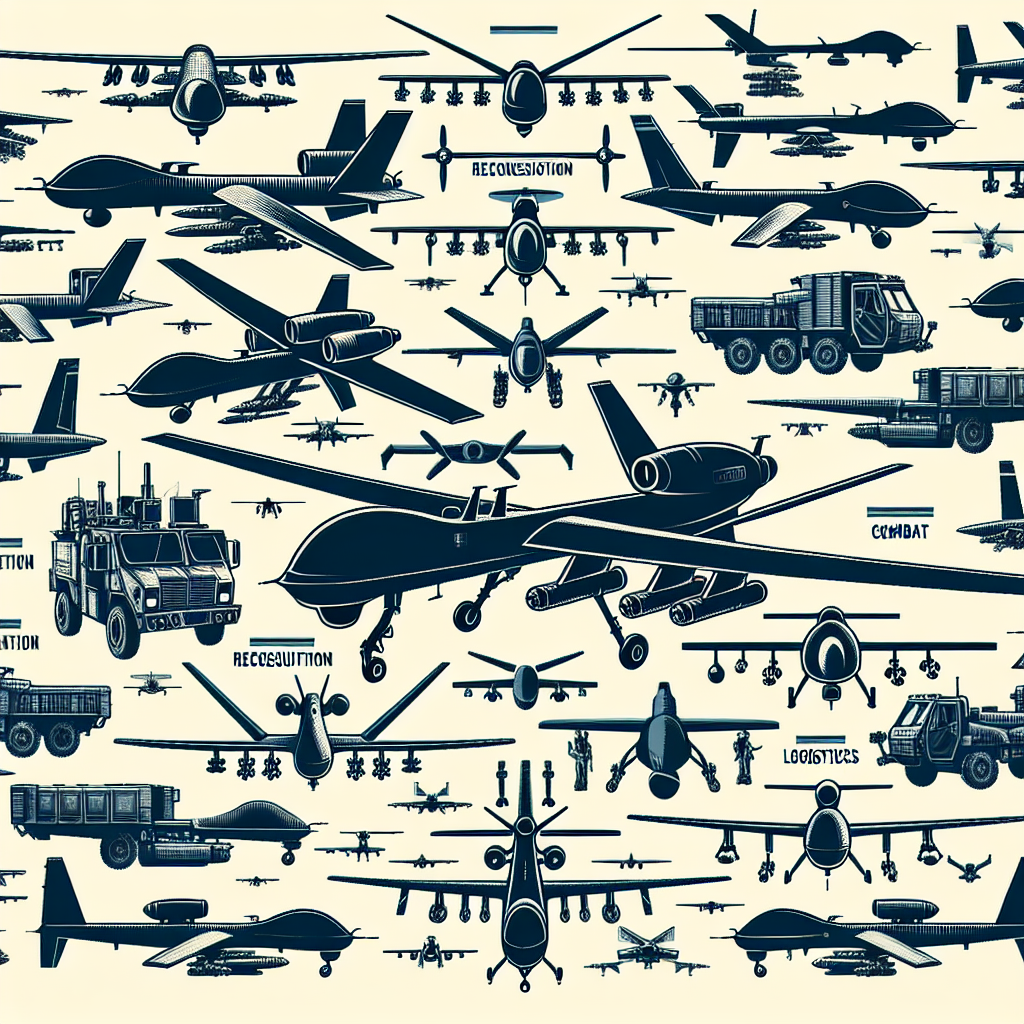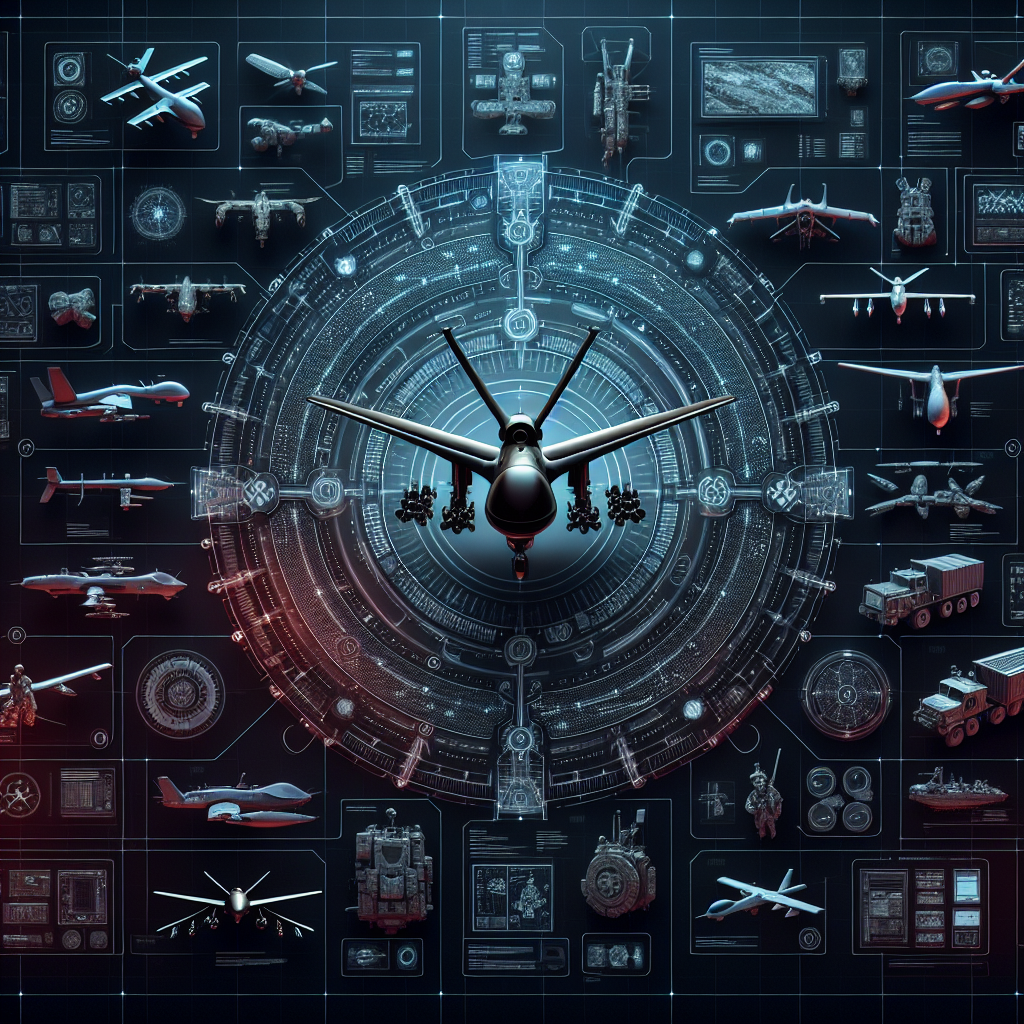Military drones have revolutionized warfare by providing an unprecedented level of surveillance, intelligence, and firepower. In this article, we will explore the different types of military drones and gain insight into the functions they serve on the battlefield. From reconnaissance to combat, these unmanned vehicles have become an indispensable tool for modern armed forces. Whether you are an enthusiast, a curious observer, or someone interested in the advancements of military technology, this article will provide a comprehensive overview of the various types of military drones and their crucial roles in military operations.

Reconnaissance Drones
Reconnaissance drones play a crucial role in gathering information and intelligence on enemy movements and activities. These drones are designed to be small, agile, and discreet, allowing them to navigate through challenging terrain and capture valuable data. There are different types of reconnaissance drones available, each with its own unique capabilities.
Micro Reconnaissance Drones
Micro reconnaissance drones are the smallest in size and are typically used for close-range surveillance and intelligence gathering. These drones are equipped with high-resolution cameras and sensors, allowing them to capture detailed images and videos of specific targets or areas. They are particularly effective in urban environments where maneuverability and stealth are essential.
Miniature Reconnaissance Drones
Miniature reconnaissance drones are slightly larger than micro drones and are capable of covering a larger area for surveillance purposes. These drones often have longer flight times and are equipped with advanced imaging systems, such as infrared and thermal cameras, enabling them to detect and track targets even in low-light conditions or through foliage.
Tactical Reconnaissance Drones
Tactical reconnaissance drones are larger and more sophisticated than micro and miniature drones. These drones have extended range capabilities and are equipped with advanced sensors, such as radar and signal intelligence systems. They can gather real-time data, monitor enemy communications, and identify potential threats from a safe distance. Tactical reconnaissance drones are vital for providing situational awareness to military commanders in the field.
Attack Drones
Attack drones, also known as combat drones, are specifically designed for offensive operations. These drones are equipped with weapons systems and can engage and eliminate hostile targets without putting human lives at risk. The use of attack drones has revolutionized modern warfare by providing precision strikes and increased operational flexibility.
Medium-Altitude Long-Endurance (MALE) Attack Drones
MALE attack drones are capable of operating at medium altitudes for extended periods. These drones are equipped with advanced surveillance and targeting systems, making them effective for both reconnaissance and offensive missions. MALE attack drones can carry a variety of weapons, including missiles and guided bombs, allowing them to engage targets with precision and accuracy.
High-Altitude Long-Endurance (HALE) Attack Drones
HALE attack drones have similar capabilities as MALE drones but are designed to operate at higher altitudes and for longer durations. These drones are often used for strategic strikes and can penetrate heavily defended airspace. HALE attack drones can be equipped with sophisticated weaponry, electronic warfare systems, and even carry out autonomous operations, making them a formidable force on the battlefield.
Unmanned Combat Aerial Vehicles (UCAVs)
Unmanned Combat Aerial Vehicles, or UCAVs, are the most advanced and lethal of all attack drones. These drones have the ability to fly autonomously, make decisions based on situational analysis, and engage multiple targets simultaneously. UCAVs can operate in highly contested environments, conduct long-range precision strikes, and provide real-time intelligence to ground forces. Their advanced capabilities make them a game-changer in modern warfare.
Target and Decoy Drones
Target and decoy drones serve a crucial role in military operations by diverting enemy attention and testing defensive systems. These drones are designed to mimic enemy aircraft or missiles, providing a realistic target for training or to draw enemy fire away from actual assets.
Target Drones
Target drones are unmanned aircraft specifically designed to mimic enemy aircraft, missiles, or drones. These drones are used for target practice, testing weapon systems, and training military personnel. Target drones can be remotely controlled or operate autonomously, simulating realistic flight patterns and behaviors to challenge weapon systems and personnel to their limits.
Decoy Drones
Decoy drones are used to deceive and distract enemy forces by mimicking friendly aircraft or emitting electronic signals to confuse enemy radar systems. By diverting enemy attention and creating a false target, decoy drones effectively protect actual assets from being detected and targeted. These drones play a vital role in electronic warfare and force protection.
Electronic Warfare Drones
Electronic warfare drones are equipped with advanced electronic intelligence and countermeasures systems, allowing them to gather intelligence on enemy communications and disrupt their electronic systems.
Electronic Intelligence (ELINT) Drones
ELINT drones are designed to intercept, analyze, and exploit enemy electronic signals. These drones gather intelligence through signals intelligence (SIGINT) and electronic support measures (ESM) systems. ELINT drones can identify and locate enemy radar, communication systems, and electronic signatures, providing valuable information for offensive or defensive operations.
Electronic Countermeasures (ECM) Drones
ECM drones are tasked with jamming or disrupting enemy communications and electronic systems. These drones are equipped with jamming pods or electronic warfare equipment, allowing them to interfere with enemy radars, communications, or other electronic systems. ECM drones are instrumental in gaining airspace dominance and disrupting enemy operations.

Logistics Drones
Logistics drones provide support and assistance in transportation and medical evacuation, ensuring effective and timely delivery of supplies and medical aid to military personnel in the field.
Cargo Drones
Cargo drones are capable of carrying heavy payloads over long distances. These drones have the potential to revolutionize logistic operations by providing a quick and efficient means of delivering supplies, equipment, and humanitarian aid to remote or inaccessible areas. Cargo drones can be autonomous or remotely controlled, offering flexibility in transporting critical resources.
Medical Evacuation (Medevac) Drones
Medevac drones are designed to transport injured soldiers or civilians from the battlefield or remote areas to medical facilities. These drones can quickly and safely evacuate casualties, providing emergency medical care en route. Medevac drones can drastically reduce response times and save lives in critical situations where traditional evacuation methods may be slower or restricted.
Communication Drones
Communication drones play a vital role in maintaining reliable and secure communication networks in the field, ensuring seamless communication between military units and command centers.
Communication Relay Drones
Communication relay drones are equipped with advanced communication systems and act as airborne relays between ground forces or other drones and command centers. These drones can extend the range and coverage of communication networks, ensuring uninterrupted and reliable communication in remote or hostile environments.
Surveillance Drones
Surveillance drones are extensively used for monitoring and observing enemy activities or providing real-time situational awareness to military commanders.
Wide-Area Surveillance Drones
Wide-area surveillance drones are capable of capturing high-resolution imagery over vast areas. These drones are equipped with powerful surveillance cameras and sensors, allowing them to monitor large swaths of territory in real-time. Wide-area surveillance drones are instrumental in border patrols, intelligence gathering, and monitoring potential threats in vast or challenging environments.
Persistent Surveillance Drones
Persistent surveillance drones are designed to operate for extended periods, providing continuous monitoring and reconnaissance capabilities. These drones are often equipped with advanced imaging systems, such as multispectral or infrared cameras, allowing them to detect and track targets for prolonged periods. Persistent surveillance drones are particularly useful for long-term surveillance missions or for monitoring suspicious activities.
Training Drones
Training drones serve as realistic targets or training aids for military personnel, enabling them to enhance their skills and proficiency in various operational scenarios.
Simulated Enemy Drones
Simulated enemy drones are used in training exercises to mimic hostile aircraft or drones. These drones provide a realistic training environment, enabling military personnel to develop tactics, techniques, and procedures against potential adversaries. Simulated enemy drones can be programmed to imitate specific threats, allowing for effective training and preparation.
Target Practice Drones
Target practice drones are unmanned aircraft used for honing marksmanship and target acquisition skills. These drones are typically small, maneuverable, and equipped with target systems that register hits. Target practice drones allow military personnel to improve accuracy and precision in a controlled and safe training environment.
Research and Development Drones
Research and development (R&D) drones are used for prototyping, testing, and evaluating emerging drone technologies and systems.
Prototyping and Testing Drones
Prototyping and testing drones are employed during the research and development phase to evaluate new technologies, designs, and systems. These drones are instrumental in testing the feasibility and performance of innovative concepts before they are integrated into operational drones. Prototyping and testing drones play a crucial role in advancing drone capabilities and ensuring their effectiveness on the battlefield.
Swarm Drones
Swarm drones are deployed in groups or swarms and operate collaboratively to achieve specific objectives. They can overwhelm enemy defenses and carry out complex missions with synchronized precision.
Autonomous Swarm Drones
Autonomous swarm drones are capable of operating independently and collaboratively, leveraging artificial intelligence and advanced algorithms. These drones can communicate with each other, distribute tasks, and adapt their strategies dynamically. Autonomous swarm drones excel in tasks such as surveillance, reconnaissance, and engaging multiple targets simultaneously. Their ability to operate as a cohesive unit with minimal human intervention is a significant advantage in modern military operations.
In conclusion, military drones have revolutionized the way armed forces conduct operations, providing enhanced capabilities and reducing risks to human lives. The different types of military drones, from reconnaissance and attack drones to logistics and surveillance drones, each serve unique functions and play critical roles in modern warfare. As technology continues to advance, drones will undoubtedly play an increasingly crucial role in achieving military objectives efficiently and effectively.

